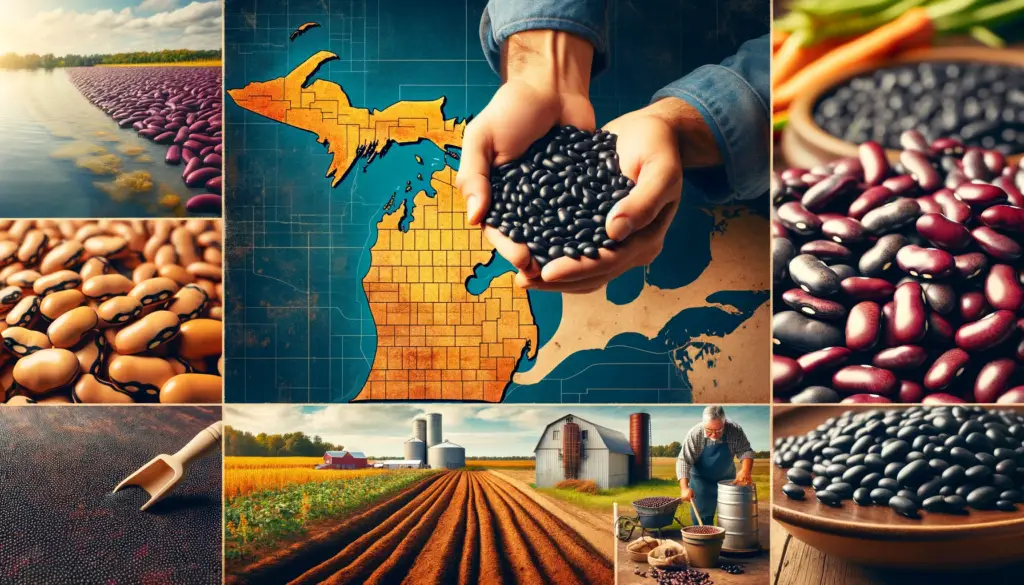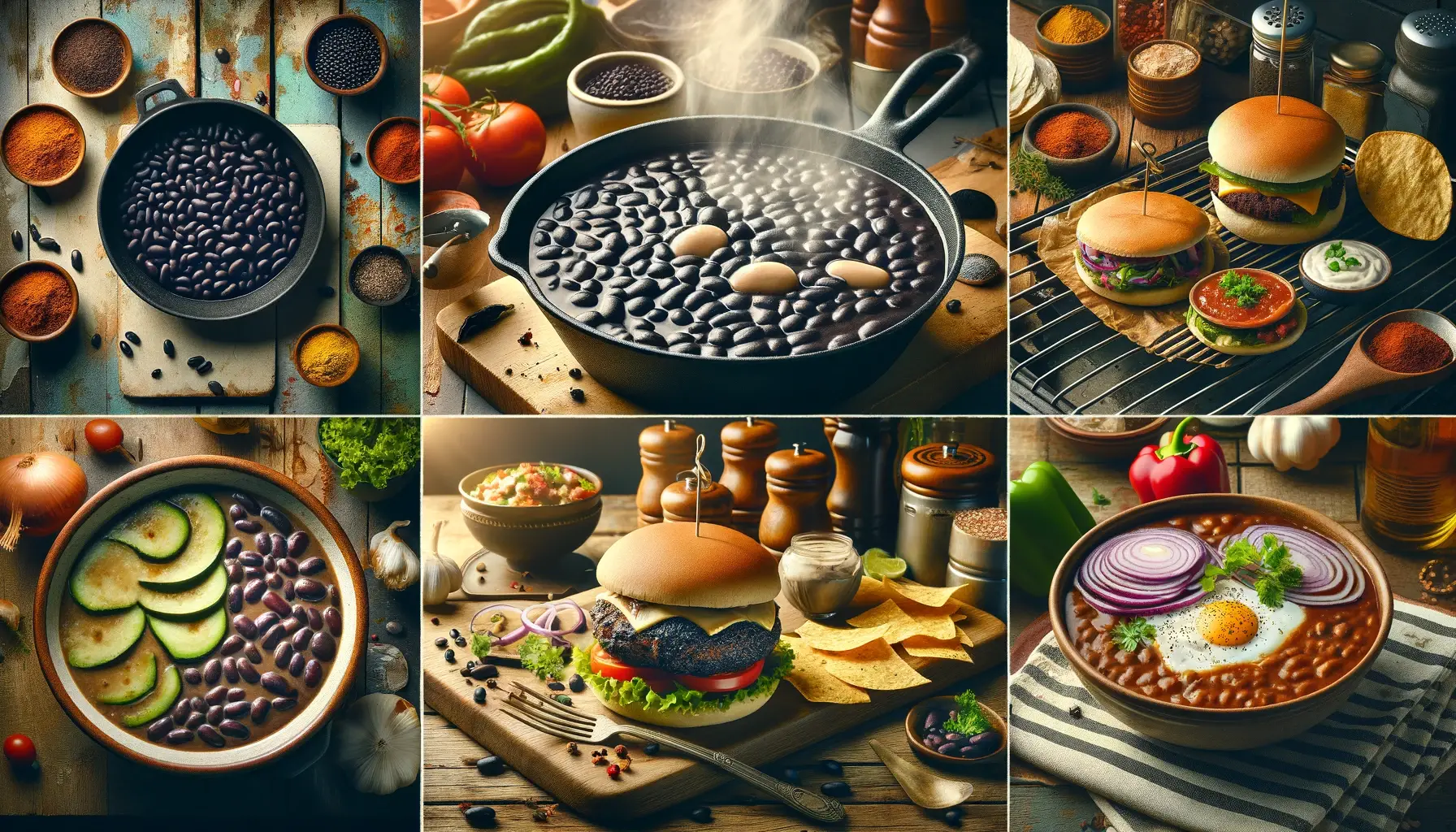Michigan black beans are medium to small, oval-shaped beans with a shiny black coat or skin, a small white eye or spot (called a “keel,”) a creamy white interior, and a pleasant mushroom-like flavor which some cooks have described as “earthy” or “meaty.”

According to the Michigan Bean Commission, Michigan is internationally known as an excellent supplier of high-quality dry beans. With rich, well-drained, loamy soil, the climate, moderate daytime temperatures, and cool evenings are suited for bean production. Michigan is the top state in the production of Black Beans, Cranberry Beans, and Small Red Beans. IN 2019 Michigan ranked third behind Minnesota and North Dakota in overall bean production.
Mexico is Michigan’s largest export market, largely made up of but not limited to high-quality Michigan black beans. In Michigan’s Upper Thumb, the town of Kinde was once known as the bean capital of Michigan.
Farmers have found that dry bean crops like black and kidney beans are reliably profitable. However, bean growers have long-term capital investment in specialized harvest equipment. Besides, there is no subsidization by the U.S. farm program, and they are susceptible to damage from wet weather, which has been prevalent in Michigan. Thus it’s considered a higher risk commodity but can yield high profits. It’s considered a good yield at 2,500 pounds per acre
How to Cook Dry Michigan Black Beans

Dry beans must be soaked before being cooked to bring out their inherent sweetness and taste. The procedure is straightforward and offers superb flavor and attractive beans! There are two techniques for soaking beans and preparing them for cooking with your favorite recipe.
The Overnight Method: Add 3 cups of cold water to each cup of dried beans in a big saucepan (or 6 cups for each pound.) Refrigerate for 8 hours or overnight. Rinse and drain the beans.
The Quick Method: Add 3 cups of boiling water to each cup of dried beans in a big saucepan (or 6 cups for each pound.) Bring to a boil and cook the beans for 2 minutes on medium heat. Allow the beans to stand for 1 hour, covered. Rinse and drain the beans.
After soaking the beans in either technique, cook them for 1 to 2 hours, or until tender. Add 1 tablespoon of vegetable oil to simmering water to avoid foam or froth.
Yummy Dishes Made With Black Beans

Black beans are a versatile ingredient that can add both nutrition and flavor to a wide range of dishes. Here are five delectable dishes that highlight the yumminess of black beans:
- Black Bean Soup: A classic and comforting dish, black bean soup is both hearty and healthy. It typically includes a blend of spices, onions, garlic, and sometimes a hint of smoky bacon or ham for added depth. It can be made creamy or left with whole beans for texture, and it’s often garnished with sour cream, cilantro, or a squeeze of lime juice.
- Black Bean Burgers: For a vegetarian twist on the traditional burger, black beans offer a robust, meaty texture. Combined with breadcrumbs, spices, and sometimes corn for a bit of sweetness, these patties are pan-fried to a crispy exterior and served with the usual burger fixings like lettuce, tomato, and avocado.
- Cuban Black Beans and Rice (Moros y Cristianos): This dish is a staple in Cuban cuisine and pairs seasoned black beans with white rice. The beans are cooked with bell peppers, cumin, and oregano, creating a flavorful dish that’s often served with a side of plantains.
- Black Bean and Corn Salad: This refreshing salad is perfect for summer picnics and potlucks. Black beans are tossed with sweet corn, diced tomatoes, avocados, and a zesty lime vinaigrette. It’s a simple, colorful, and refreshing dish that’s loaded with fiber and protein.
- Black Bean Enchiladas: In this Mexican-inspired dish, black beans are wrapped in corn tortillas and smothered with enchilada sauce and cheese. They are baked until bubbly and often topped with green onions, olives, and sour cream. This dish can be customized with additional fillings like chicken, beef, or vegetables.
Best Tips for Dealing With Gas
Beans can produce flatulence due to natural compounds known as oligosaccharides. These are sugar molecules with a molecular makeup that makes them difficult to digest at times. They are transported to the lower intestine without being broken down and cause painful gas. Fortunately, the gas-producing effects of beans may be reduced by following a few easy steps:
- Invest in the most recent crop of dry beans. The fresher the bean, the less likely you will have stomach issues.
- Always soak and drain your beans before cooking. The more oligosaccharides are released into the soaking water, the longer the beans are soaked. Before cooking, drain and rinse the beans, reserving the soaking water.
- Beano, a commercial natural enzyme product, breaks down the complex carbohydrates in beans, making them simpler to digest.
Final Thoughts
In conclusion, black beans are not just a cornerstone of healthful eating; they’re a culinary chameleon, adept at enhancing a wide array of dishes with their rich, earthy flavor and satisfying texture. From the hearty comfort of a simmering pot of black bean soup to the innovative and environmentally conscious choice of black bean burgers, these legumes are a testament to the versatility and delight that simple ingredients can bring to our tables. Whether folded into the vibrant layers of a black bean and corn salad or tucked into the saucy embrace of enchiladas, black beans prove that nutritious food can be both indulgent and accessible. As we’ve explored just a handful of the many ways to celebrate black beans, it’s clear they offer a world of culinary possibilities worth exploring, each dish a delicious opportunity to savor the rich agricultural tapestry of the Michigan Thumb region.
Related Reading For Cooking

Tips and Tricks for Cooking Mussels and Other Seafood to Perfection
College Budget Cooking – 4 Delicious Recipes for Hungry Minds
Master Hot Dog Grilling Techniques at Home
Beef Jerky Varieties: Discover 7 Amazing Types for Your Palate
Master the Grill: 7 Essential Hot Dog Grilling Tips for the Perfect BBQ
Dining at Wisma Atria – Explore the Best Dining in Singapore’s Popular Shopping Mall
Bring Warmth to Your Friends’ New Home with These Top Housewarming Gift Picks




